by tmoffett | Jul 23, 2012 | Color, Composition, Critique, Landscape, Photographic Technique, Uncategorized
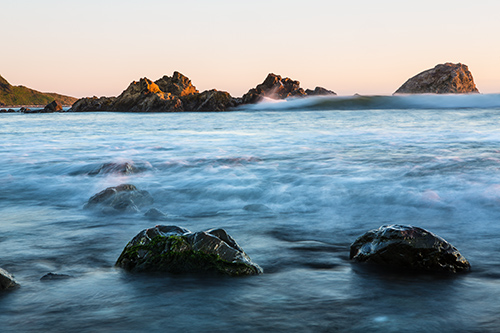
Ocean View, Crescent City, CA
I haven’t been out photographing for a few days and I am starting to get a bit antsy. I have been sitting in front of my computer getting some much needed work done, but I need to photograph. It doesn’t matter that I have a backlog of images to process and other tasks that need worked on, the need to make new images is always there. I guess that means I am a photographer. It is in my blood.
I pulled this image to post from my last trip to the coast. We were in Crescent City, California to photograph the Redwoods, but when I am close to the ocean, I will always find time to spend there. The evening I made this photograph, the sky was naked and colorless, so I really focused on the sea. One thing that I stress in my classes and workshops is to work the camera angles. Many times, especially at the ocean, I find photographers up on the beach, away from the water but shooting the water from a high angle. Not me. I like to be in the water. I try to find a lower angle to shoot from, as this will emphasize the foreground objects better. I have found that if I press my tripod down in the sand it becomes very stable. Unless a big wave slams into the tripod, it is remains quite stable in the water even at long shutter speeds. This image is a 1.3 second exposure, tripod legs buried under about 18 inches of water and waves hitting the tripod legs. The image is still tack sharp. When photographing this way you must keep an eye on the incoming waves, as occasionally a sleeper wave will come out of nowhere and you better be ready to move or risk soaking all of your gear. For this image, I actually wanted to get lower, but when I did, the incoming waves blocked the view of the rocky background too much.
One thing I really like about this image is not only the emphasis on the foreground rocks, but how the low angle also enlarges the size of the wave coming in. The wave creates a nice transition from ocean to rock in the background. I know it is hard to see in the small image here, but the water is packed with texture, detail and subtle color shifts, showing the warm light of the setting sun reflecting off of the highlights, but the deeper parts of the water remain a rich and vibrant blue. There is a lot of life in the finished print.
by tmoffett | Apr 19, 2012 | Color, Composition, Critique, Landscape, Photographic Philosophy
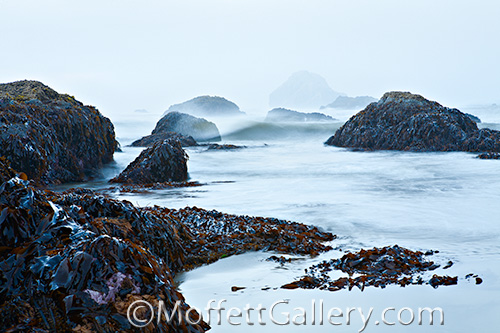
Shoreline at Bandon, Oregon
This happens to be one of my favorite images that I have made along the Oregon Coast. It was a cool, breezy morning and the marine layer was thick, which meant that I would have no dramatic sky. On the coast that is not unusual. I really like what happens here, though. The fog allows for the ocean to appear to vanish into the sky, creating a vastness that otherwise may not be apparent. The thick fog and bluish color of the image helps in creating a coolness, resembling my feelings as I photographed. My images are always about my feelings. It may be what I see, but even more about how I see and what I feel. This particular morning I was cold and wet as I walked the beach in search of an image. I knew, as I walked around the rocks to this location, that I had found what I was looking for. I must have spent 30 minutes or more just watching and dodging the waves as they rushed ashore, finding the correct angle for the composition that said what I wanted and timing the exposure to capture the motion of the water, creating an image resembling the feelings inside of me. When everything comes together as it did here, I am amazed at what can happen.
Photography is really not about the final image, it is about the experience, living the experience and then sharing it through the photographs created.
by tmoffett | Jul 14, 2010 | Black and White, Composition, Critique, Landscape, Photo tips
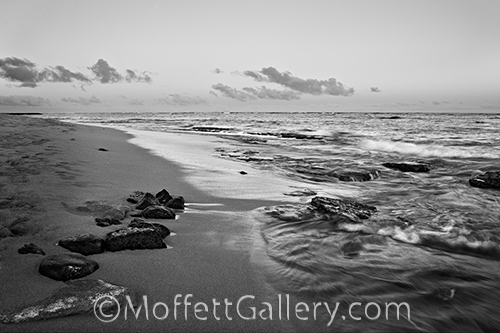
Kapaa Shoreline
Now that we all shoot digital cameras, I think many have forgotten that black and white is even an option. We are shooting color because that is what the camera does. We shoot color for colors sake, and often forget about light quality and tonal range of the image that we are creating. Often, I see images where the color actually gets in the way of the photograph. Toss out the color and the image improves. The photograph above is just such an example, in color, it was very busy. Yellows and reds on the beach, pink and blue in the sky, greens and blues in the water. The placement of the colors just didn’t work, but the tones of the scene were very nice. Learning to see the tones instead of the color is what will make a great black and white photographer.
Shooting for black and white is an art in and of itself that when mastered will dramatically improve your color photography as well. In order for an image to be good in black and white we must look at the tones of the scene. How light is the lightest area and how dark is the darkest area. Morning and evening light, often referred to as the sweet light or the golden hour, give us a reduced contrast and softer light so that detail can be maintained in both highlight and shadow. These are the times of day when I do most of my serious photographing. The light is exciting and most anything will look good.
This image was shot just prior to sunset on the beach in Kauai. The light skimmed across the waves so as to create very nice highlights in the moving water, yet allowed the shadow areas to go dark and rich while still maintaining some detail. Also, as I discussed yesterday, the rule of thirds is used here. I was not consciously thinking about it, but having developed an eye for composition, it just happens. Notice when a grid is placed over the photograph, where the intersecting points fall. 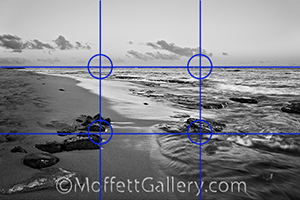 On the rocks to the left, the reef on the right and also the horizon line is on the top horizontal grid line.
On the rocks to the left, the reef on the right and also the horizon line is on the top horizontal grid line.
Practice shooting black and white and apply the principles of composition and watch your photographs improve!
by tmoffett | Jul 12, 2010 | Color, Composition, Critique, Landscape
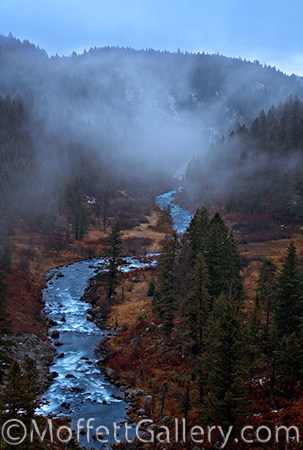
Warm River
A few days ago I posted Tunnel Vision. This is a view the other direction. A beautiful view overlooking Warm River. This is another image that seems to have grown on me. Originally I was not real fond of the image, but over time it has become a favorite. The low-resolution internet version does not do it justice. You really need to see the print in person.
The fog began moving in the canyon as the light diminished and became quite a remarkable sight. The blue from the sky became the light source and created an interesting, almost surreal palette to the scene. The long exposure (20 seconds) created a soft, smooth flow of the river wandering through the image from left to right. The blue of the sky reflected off the water and nicely contrasts with the reds and yellows of the fall foliage along its banks. Everything seemed to work out just right, and I happen to be in a place at the right time to create the photograph. Timing is everything in landscape photography.
by tmoffett | Jul 9, 2010 | Architecture, Color, Critique, Photographic Philosophy
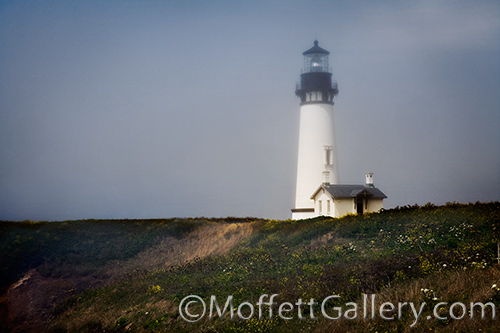
Yaquina Head Lighthouse
I don’t know what it is about this image. I initially didn’t think too much of it, but every time I have reviewed the set of images from my Oregon Coast 2009 trip, this one stands out more and more. It is kind of growing on me, I guess.
I have found over the years that certain images will really appeal to me initially, and over time kind of fade away, and others will take time to grow on me, but I seem to never tire of them. For this reason, I always do an initial edit of my work, but review it several time over the course of several months or even years. Often I find little gems that I missed at first. This is one of those.
When I was at Yaquina Head, the fog was rolling in from the sea and you could barely see the top half of the lighthouse. We hiked down to Cobble Beach and occasionally the fog would grow thin and you could see the top, however it left a unique softness to the image. I think that is what is drawing me in. The subtle color and softness create a very passive feeling, very relaxing to look at. It is very different from the stark, crisp and sharp architectural images that we are used to seeing. I kind of like it for a change.
by tmoffett | May 27, 2010 | Color, Critique, Landscape, Photo tips

The Falls
In the Spring, when the runoff is at its peak, a trip to Shoshone Falls is a must. While descending to the falls, I noticed this small waterfall off to the side. Thousands of people were down at the main falls, so I stopped here for a few minutes to photograph in solitude. After a creating few images of the whole falls, top to bottom, I just wasn’t happy with where it was going. I stopped and thought about what was really drawing me in, and it was just the base of the falls, the flowing water and the mist. I focused my vision to that, and this is what I came up with. I love the interaction of the water with the rocks. Strong, sharp solid rock and smooth flowing water in the evening light. Life just doesn’t get much better.









Recent Comments